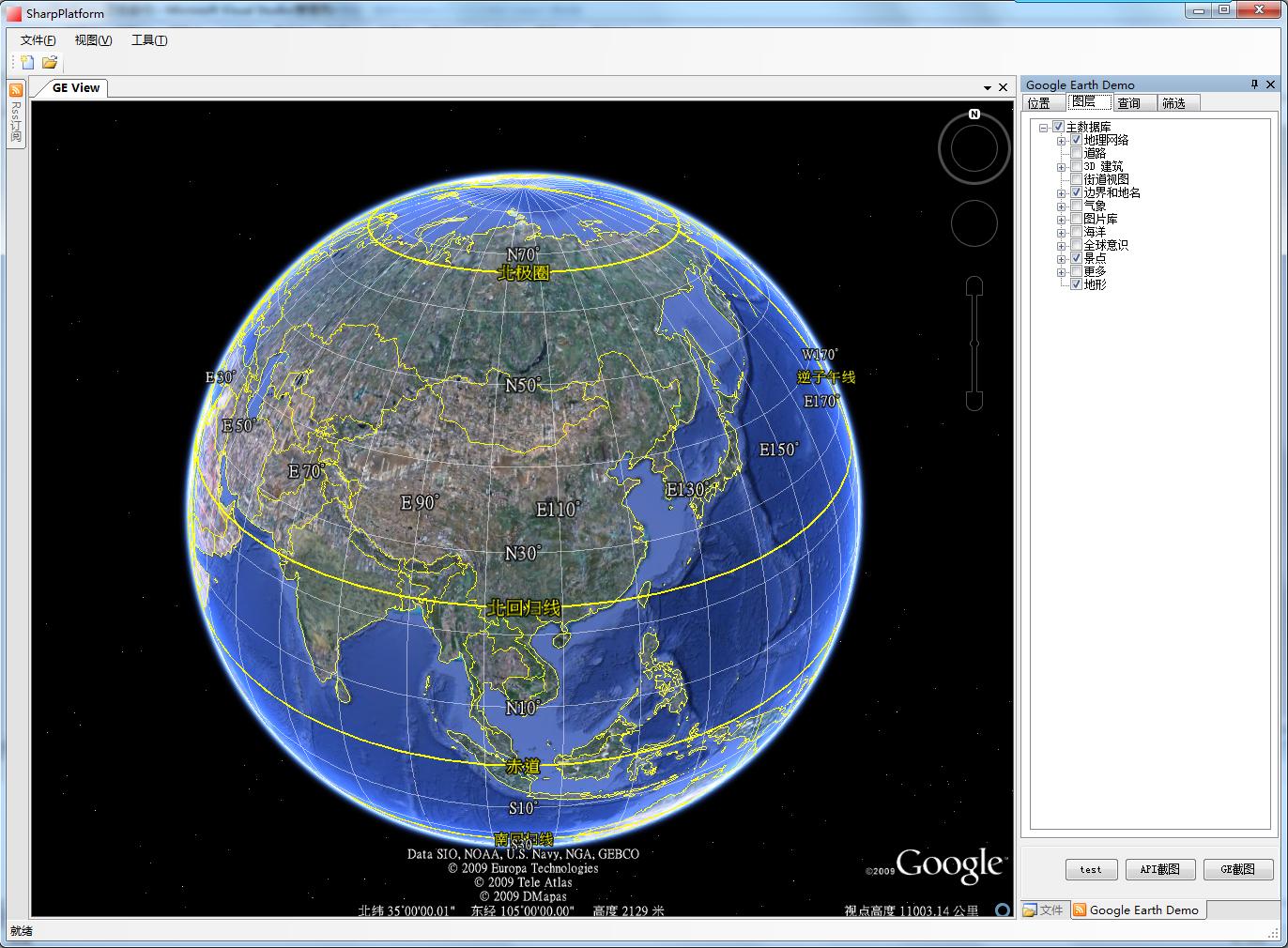本篇繼續介紹Google Earth COM API開發的基礎知識,相對第三篇的改進如下:
1)增加鼠標滾輪支持,可以實現放大、縮小。此功能利用上一篇提供的HookAPI.dll實現
2)讀取PlaceMarks(Google Earth界面中的位置)並顯示、隱藏
3)讀取所有圖層,顯示並隱藏
下面,繼續放代碼:
1、鼠標滾輪事件,實現放大、縮小
1: ...
2: // 放大
3: private const long ZoomIn = 0x00780000;
4: // 縮小
5: private const long ZoomOut = 0xFF880000;
6: ...
7: mouseHook.MouseWheel += new MouseEventHandler(mouseHook_MouseWheel);
8: ...
9: /// <summary>
10: /// 鼠標鉤子。鼠標滾動事件
11: /// </summary>
12: /// <param name="sender"></param>
13: /// <param name="e"></param>
14: void mouseHook_MouseWheel(object sender, MouseEventArgs e)
15: {
16: IntPtr hWnd = NativeMethods.WindowFromPoint(e.Location);
17: if (hWnd == this.GeRenderHWnd)
18: {
19: Point point = this.Control.PointToClient(e.Location);
20: // 如果鼠標位置在控件內部,則說明鼠標在GoogleEarth視圖范圍內進行了滾動
21: if (this.Control.ClientRectangle.Contains(point))
22: {
23: NativeMethods.PostMessage(GeRenderHWnd, (int) WM_MOUSE.WM_MOUSEWHEEL, e.Delta == 120 ? ZoomIn : ZoomOut, 0);
24: }
25: }
26: }
2、讀取PlaceMarks
Google Earth COM API中提供了兩個讀取PlaceMarks的函數。一個是GetTemporaryPlaces(),用來讀 取臨時位置;另一個是GetMyPlaces(),用來讀取自定義位置,即GoogleEarth中顯示的“我的位置”。呵 呵
1: ...
2: /// <summary>
3: /// 顯示位置“PlaceMarks”。位置分為兩種,一種時TemporaryPlaces,另一種為 MyPlaces
4: /// </summary>
5: protected void ShowPlaces()
6: {
7: Thread.Sleep(500);
8: // 獲取MyPlaces
9: FeatureGE myPlace = GeApp.GetMyPlaces();
10: // 獲取臨時位置
11: FeatureGE temporaryPlace = GeApp.GetTemporaryPlaces();
12: //
13: List<FeatureGE> places = new List<FeatureGE>();
14: places.Add(myPlace);
15: places.Add(temporaryPlace);
16:
17: // 獲取工具面板
18: GEToolPad toolPad = GetToolPad();
19: // 顯示所有位置
20: toolPad.ShowPlaces(places);
21: }
22: ...
23: /// <summary>
24: /// 顯示所有PlaceMarks(位置)
25: /// </summary>
26: /// <param name="places"></param>
27: public void ShowPlaces(List<FeatureGE> places)
28: {
29: if (this.InvokeRequired)
30: {
31: Action method = delegate {
32: InternalShowPlaces(places);
33: };
34:
35: try
36: {
37: this.Invoke(method);
38: }
39: catch { }
40: }
41: else
42: {
43: InternalShowPlaces(places);
44: }
45: }
46: /// <summary>
47: /// 顯示所有PlaceMarks(位置)。被ShowPlaces函數調用
48: /// </summary>
49: /// <param name="places"></param>
50: protected void InternalShowPlaces(List<FeatureGE> places)
51: {
52: this.tvPlaces.Nodes.Clear();
53:
54: if (places == null || places.Count <= 0)
55: return;
56:
57: foreach (FeatureGE place in places)
58: {
59: TreeNode node = new TreeNode(place.Name);
60: node.Checked = place.Visibility > 0;
61: node.Tag = place;
62:
63: ShowChildrenPlaces(place, node);
64:
65: node.Expand();
66:
67: this.tvPlaces.Nodes.Add(node);
68: }
69: }
70: /// <summary>
71: /// 顯示指定PlaceMark的子PlaceMark
72: /// </summary>
73: /// <param name="place">父PlaceMark</param>
74: /// <param name="node">父節點</param>
75: protected void ShowChildrenPlaces(FeatureGE place, TreeNode node)
76: {
77: FeatureCollectionGE places = place.GetChildren();
78:
79: foreach (FeatureGE child in places)
80: {
81: TreeNode tn = new TreeNode(child.Name);
82: tn.Checked = child.Visibility > 0;
83: tn.Tag = child;
84:
85: ShowChildrenPlaces(child, tn);
86:
87: node.Nodes.Add(tn);
88: }
89: }
3、讀取圖層
1: ...
2: /// <summary>
3: /// 顯示圖層
4: /// </summary>
5: protected void ShowLayers()
6: {
7: Thread.Sleep(500);
8: // 獲取所有圖層信息
9: FeatureCollectionGE layers = GeApp.GetLayersDatabases();
10: // 獲取工具面板
11: GEToolPad toolPad = GetToolPad();
12: // 顯示所有圖層
13: toolPad.ShowLayers(layers);
14: }
15: ...
16: /// <summary>
17: /// 將給定的圖層集合顯示在“圖層”選項卡的樹形控件中
18: /// </summary>
19: /// <param name="layers">圖層集合</param>
20: public void ShowLayers(FeatureCollectionGE layers)
21: {
22: if (this.InvokeRequired)
23: {
24: Action method = delegate {
25: InternalShowLayers(layers);
26: };
27: try
28: {
29: this.Invoke(method);
30: }
31: catch { }
32: }
33: else
34: {
35: InternalShowLayers(layers);
36: }
37: }
38: /// <summary>
39: /// 將給定的圖層集合顯示在“圖層”選項卡的樹形控件中.被公共函數ShowLayers調用
40: /// </summary>
41: /// <param name="layers"></param>
42: protected void InternalShowLayers(FeatureCollectionGE layers)
43: {
44: this.tvLayers.Nodes.Clear();
45:
46: if (layers == null || layers.Count <= 0)
47: {
48: return;
49: }
50:
51: foreach (FeatureGE layer in layers)
52: {
53: TreeNode node = new TreeNode(layer.Name);
54: node.Checked = layer.Visibility > 0;
55: node.Tag = layer;
56:
57: ShowChidrenLayers(layer, node);
58:
59: node.Expand();
60:
61: this.tvLayers.Nodes.Add(node);
62: }
63: }
64: /// <summary>
65: /// 顯示指定圖層的子圖層
66: /// </summary>
67: /// <param name="layer">當前圖層</param>
68: /// <param name="node">當前節點</param>
69: protected void ShowChidrenLayers(FeatureGE layer, TreeNode node)
70: {
71: FeatureCollectionGE layers = layer.GetChildren();
72:
73: foreach (FeatureGE child in layers)
74: {
75: TreeNode tn = new TreeNode(child.Name);
76: tn.Checked = child.Visibility > 0;
77: tn.Tag = child;
78:
79: ShowChidrenLayers(child, tn);
80:
81: node.Nodes.Add(tn);
82: }
83: }
呵呵,代碼很簡單。按照此代碼修改第三篇的源程序就可以實現本篇的功能了。
